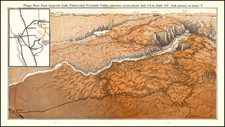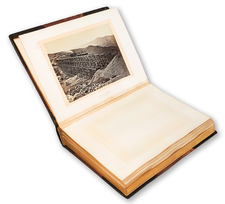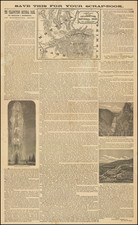Watkins Mammoth Plate Photograph of Sentinel Rock, Yosemite
"Mr. Watkin's admirable photograph renders it with fine effect" - Josiah Whitney
"Carleton E. Watkins was a giant of photography. He is arguably America's greatest landscape photographer" - Palmquist & Kailbourn
An original mammoth-plate photograph of Sentinel Rock, in Yosemite, by the outstanding 19th century photographer of the American West, Carleton Watkins.
In 1861 Watkins began making his famous series of large-scale "mammoth-plate" photographs in California's Yosemite Valley -- these views are now unanimously accepted as some of the most beautiful photographic images ever made in the West. Watkins's Yosemite photographs were influential in persuading the United States Congress to pass pioneering legislation to preserve the Yosemite Valley, which bill, the Yosemite Valley Grant Act, was signed into law by Abraham Lincoln on June 30, 1864. This law granted Yosemite Valley and the Mariposa Grove to the State of California, "to be held for public use, resort, and recreation...[the use of which in this manner] shall be inalienable for all time." Watkins was consulted by Yosemite Commissioner Frederick Law Olmsted on the best means to preserve Yosemite as a public trust. It wasn't until 1890, through the efforts of John Muir and others, that Yosemite was signed into existence as the nation's third National Park.
While the technical and aesthetic qualities of Watkins's Yosemite photographs were early lauded by enthusiasts and experts alike, including William H. Brewer of the California State Geological Survey ("the finest I have seen"), J. D. Whitney (who bestowed Watkins's name on an 8,500-foot peak in Yosemite) and Oliver Wendell Holmes (the foremost photography critic of the time who said Watkins's photographs reached "a perfection of art which compares with the finest European work"), it wasn't until the 1970s that Watkins was re-discovered by the photographic art world, thus shining a brighter light on his life and work. Watkins's mammoth-plate views of Yosemite are now solidly ensconced as part of the canon of fine art photography. Examples of Watkins's Yosemite photographs are in many great institutional collections, including those in the Bancroft Library, the Getty, the Metropolitan Museum of Art, the Huntington Library, and numerous other institutions.
The present view was a particular favorite of Josiah Whitney, California State Geologist and author of the Yosemite Book (1869):
This view represents a return to the site of [an earlier view]. The passage of time is recorded by differences in foliage along the riverbank. Josiah Whitney commented on the small version of this picture: "Mr. Watkin's admirable photograph renders it with fine effect, giving also the charchater of the vegetation of mingled pines, oaks and poplars along the banks of the Merced."
One of the reasons the water in the foreground of the present print appears stronger than Sentinel Rock itself might be related to the manner in which water absorbs ultraviolet light, reducing the effects of atmospheric conditions such as haze or fog.
Watkins photographed this site along the Merced River repeatedly over a period of twenty years. Seasonal variations, as well as those of water level and foliage development, often created profound differences between visits - Carleton Watkins : Photographs from the J. Paul Getty Museum, page 30 (referencing a later, ca. 1872-78, view made from the same place).
Watkins assigned his own catalogue numbering to his Yosemite photographs, with the present view conforming very closely (if not precisely) to CEW 33.
Mammoth-Plate Camera.
Watkins made the negative for this image using his custom made oversized camera. This camera was constructed by a local San Francisco instrument maker to handle negatives as large as 18 x 22 inches (the so-called mammoth-plate format).
Watkins's most famous visit to Yosemite Valley took place in the summer of 1861, when the photographer brought with him for the first time a special camera designed to accommodate sheets of glass 45.7 x 55.9 cm (18 x 22 inches) in size that were popularly called "mammoth plates." Exactly how Watkins procured this highly unusual oversize camera is uncertain. One possibility is that it was fabricated by someone such as Thomas Tennant, who advertised his services in Hutchings's magazine as an instrument maker on Battery Street in San Francisco. - Naef & Hult-Lewis, page 45.
Watkins's Autograph
According to Weston Naef and Michael Hargraves, the style and character of Watkins' handwriting evolved over time. Specifically, the way he formed the W in his name changed from having pointed bottoms to having curved bottoms. This change, which happened sometime in 1861 (or possibly as late as 1863), was accompanied by additional modifications to his signature marked by spaces where he lifted the pen from the writing surface at mid stroke. Oddly enough, by 1872 Watkins had reverted to the pointed-bottom W.
An aid to dating the photograph at hand. Naef and Hargraves state there are few prints with Watkins's autograph signature made between about 1865 and 1875. This is because he was too busy in the field, carting around his mammoth-plate camera up and down the Pacific Coast, to be able to sign many prints.
The present photograph bears an autograph signature that conforms in every detail to Watkins's pre-1872 autograph, i.e. it has a curved-bottom W, with instances where he has lifted the pen from the writing surface causing a space interruption in the line. The signature here matches one described in Naef's catalogue as having been made by Watkins ca. 1865-1866, and, given the unlikelihood of a 1865-1875 signed print, evidence points to 1865 as the date of the present print.
Rarity
Original signed mammoth plate Yosemite prints by Watkins from this early period (ca. 1865) are rare in the market.
Versions of this image are held in important photographic collections, including: the Bancroft Library, UCLA, Baltimore Museum of Art, Cooper-Hewitt, Harvard, Royal British Columbia Museum, Stanford University, Buffalo and Erie County Public Library, and the Yosemite Museum.
Carleton Watkins (American, 1829-1916) was one of the most highly acclaimed of early western photographers, yet Watkins's work has never been fully cataloged. No complete listings of his "Old Series" stereoviews, published before 1875, are known.
Watkins extensively photographed early San Francisco, Yosemite, Mendocino and the Sierra Nevada mining regions. His photogaphs of Yosemite helped influence Congress and President Lincoln in the preservation of Yosemite Valley. Watkins also made some of the earliest photographs of Southern California and the Pacific Nortwest. Watkins' Pacific Railroad series documents construction of the trans-continental railroad from Sacramento to Utah.











![[Original photograph:] Alligator Head Point. La Jolla.](https://storage.googleapis.com/raremaps/img/small/82799.jpg)
![(Chicago World's Fair & St. Paul, Minn.) [Contemporary album of 71 Photographs of St. Paul and Chicago World's Fair, Columbian Exposition]](https://storage.googleapis.com/raremaps/img/small/87334.jpg)
![(Mexican Antiquities - Photography) [Great Palace, Mitla, Oaxaca, Mexico; Grand Palais, à Mitla] [Plate 10 from:] Cités et Ruines Américaines](https://storage.googleapis.com/raremaps/img/small/93939.jpg)


